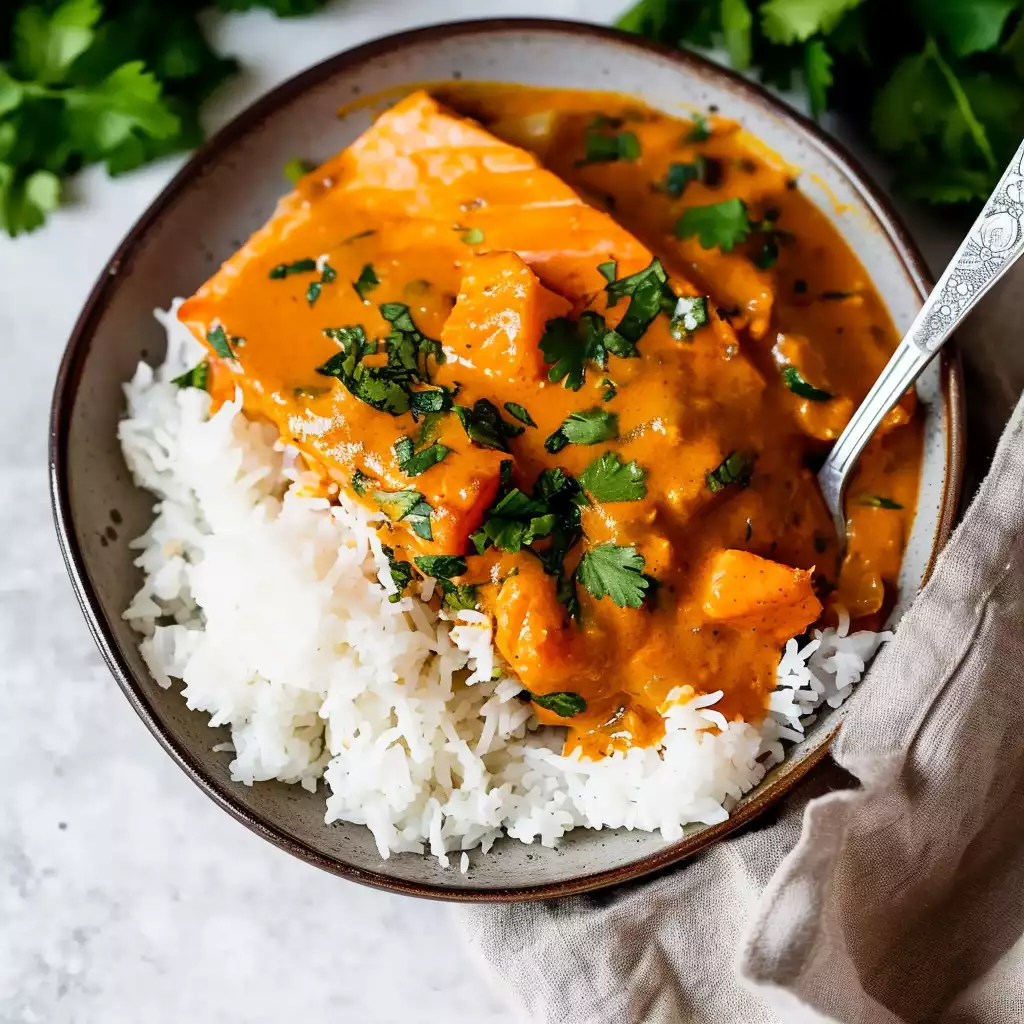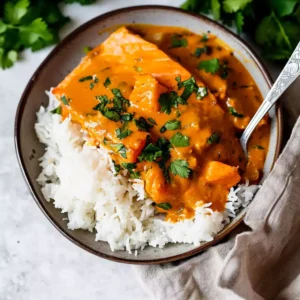
Salmon Tikka Masala is a dish that brilliantly marries the robust flavours of Indian cuisine with the delicate nature of salmon. Originating from the iconic tikka masala, this recipe swaps the usual chicken for salmon, creating a dish that is both innovative and deeply rooted in culinary traditions.
The history of tikka masala is somewhat debated. While it’s commonly associated with Indian cuisine, many believe it was actually created in Britain, a delicious product of culinary fusion. This version, with salmon, is a testament to the recipe’s versatility and adaptability.
Making Salmon Tikka Masala isn’t too difficult. The process involves marinating the salmon in a blend of yogurt and spices, then cooking it in a tomato-based sauce. The result is a dish that balances the rich flavours of spices with the natural taste of the salmon.
There are numerous variations of tikka masala, from the classic chicken to vegetarian options using paneer or vegetables. Our Salmon Tikka Masala is a unique take on this dish, offering a new experience even for those familiar with the traditional recipe.
The key to this dish lies in its spice mix – ground cumin, coriander, turmeric, garam masala, paprika, and chilli powder. Each spice contributes its own character, creating a complex and layered flavour profile.
The yogurt in the marinade helps tenderise the salmon and melds the spices together, while the cream added towards the end of cooking gives the sauce a luxurious, silky texture.
Salmon, the star of this dish, brings its own unique qualities. Its rich, fatty texture contrasts beautifully with the spices, absorbing them to create a flavourful yet not overpowering experience.
The use of salmon also makes this dish a wonderful option for those looking to incorporate more fish into their diets.
This Salmon Tikka Masala recipe is a celebration of fusion cuisine, demonstrating how traditional recipes can be adapted and transformed with local ingredients and preferences.
It’s a dish that invites experimentation, encouraging cooks to play with different spice levels and marinade times to suit their tastes.
For anyone looking to try something new in the kitchen, this recipe is a fantastic choice. It’s a dish that promises warmth, comfort, and a burst of flavours – a perfect meal to share with family and friends, or to enjoy as a special treat for oneself.
Expert Tip: Experiment with the level of spices to suit your taste. The beauty of this dish lies in its adaptability, so feel free to adjust spices like chilli powder or garam masala to your liking.
Salmon: Salmon is ideal for this recipe because of its firm texture and rich flavour, which holds up well against the strong spices. If salmon isn’t available, a good alternative could be another firm-fleshed fish like cod or haddock.
The oily nature of salmon also means it absorbs the spices beautifully, contributing significantly to the dish’s overall taste profile.
Natural Yogurt: Yogurt is crucial for tenderising the salmon and acting as a base for the marinade. It blends the spices well and imparts a creamy texture. Greek yogurt can be a good alternative, offering a similar texture and tanginess.
Ground Cumin: This spice adds a warm, earthy note. Cumin is essential for creating the authentic flavour of tikka masala. If unavailable, ground caraway seeds, although slightly different in taste, could be used as a substitute.
Ground Coriander: Known for its slightly citrusy, nutty flavour, ground coriander complements both the fish and the other spices. If you don’t have coriander, a mix of ground cumin and fennel might work as an alternative.
Ground Turmeric: Turmeric provides a beautiful colour and a subtle earthy flavour. It’s irreplaceable for the authentic colour it imparts, but in a pinch, a small amount of mustard powder might mimic some of its earthy tones.
Garam Masala: This blend of ground spices is key for the depth and warmth in the dish. Each garam masala mix is unique, so it’s hard to find an exact substitute, but a mix of ground cinnamon, cloves, and nutmeg can provide a similar aromatic quality.
Paprika: Paprika adds a sweet and smoky flavour, enhancing the overall taste. Smoked paprika could be a great alternative for an even deeper smokiness.
Chilli Powder: It introduces heat to the dish. The amount can be adjusted to suit taste. Cayenne pepper is a good substitute if you’re looking for similar heat levels.
Vegetable Oil: It’s used for cooking the base ingredients. Any neutral oil like canola or sunflower oil can be used as a substitute.
Onion: The onion adds sweetness and depth. It’s a fundamental ingredient in many curries. Shallots could be used for a slightly different, more delicate flavour.
Garlic: Garlic adds a pungent, earthy flavour. It’s hard to replace, but if needed, garlic powder or a small amount of finely chopped shallots could be used.
Ginger: Ginger brings a fresh, zesty note to the dish. In its absence, a small amount of ground ginger can be used, although the fresh flavour will be less pronounced.
Chopped Tomatoes: These add acidity and body to the sauce. If tinned chopped tomatoes aren’t available, fresh tomatoes can be used, although the cooking time may increase.
Double Cream: It gives the sauce richness and smoothness. A good alternative could be coconut cream for a dairy-free version, though it will add a slight coconut flavour.
Salt and Pepper: These seasonings are essential for enhancing all the other flavours in the dish.
Fresh Coriander Leaves: They add a burst of freshness and colour. If coriander isn’t to your taste, a sprinkle of parsley can work as a garnish, though the flavour profile will change.
Expert Tip: Marinate the salmon for at least an hour or overnight if possible. This enhances the depth of flavour and tenderises the fish, making it more succulent.
Yes, you can prepare parts of this dish in advance. The salmon can be marinated overnight, which can actually enhance the flavours. The sauce can also be made ahead and refrigerated. When ready to serve, simply cook the salmon in the sauce and add the cream.
Certainly! If you’re looking for a dairy-free option, coconut cream is an excellent substitute for double cream. It will add a slight coconut flavour to the dish but works well with the other spices.
The heat level in Salmon Tikka Masala primarily comes from the chilli powder. To adjust the spiciness, simply increase or decrease the amount of chilli powder. If you’re sensitive to spice, start with a small amount and adjust to taste.
Salmon Tikka Masala is traditionally served with steamed rice, naan bread, or both. These accompaniments help to soak up the delicious, creamy sauce. You might also enjoy it with a side of cooling cucumber raita or a simple salad.
Yes, you can use frozen salmon. Just make sure to thoroughly defrost it before using. Pat the salmon dry after defrosting to remove excess moisture. This helps the marinade stick better to the fish.
Leftover Salmon Tikka Masala can be stored in the refrigerator for up to two days. Ensure it’s stored in an airtight container. When reheating, do so gently to avoid overcooking the salmon.
Expert Tip: When cooking the salmon in the sauce, be gentle. Overcooking can make the fish tough. It only needs a few minutes, as salmon cooks quickly.
Here are some more recipes for you to enjoy! If you my recipes don’t forget to rate and leave a comment.
If you have any recipe suggestions, please do not hesitate to ask me. A great way to stay in contact with me is through Instagram, Facebook, Twitter and YouTube. Don’t forget to tag me @CookwithNabeela in your recipe photos!

Subscribe now to receive my latest recipes directly in your inbox. Stay up-to-date and never miss out!

I love to cook! I want to share with you my favourite, delicious family-friendly recipes. I want to inspire you to create fantastic food for your family every day.
Add your first comment to this post